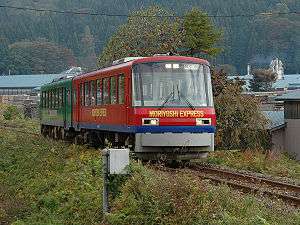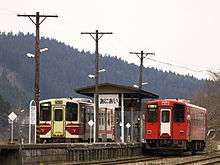Akita Nairiku Line
The Akita Nairiku Line (秋田内陸線, Akita Nairiku-sen) is a Japanese railway line located in Akita Prefecture in northern Japan. It operates between Takanosu in the city of Kitaakita and Kakunodate in the city of Senboku. The Akita Nariku Line is the only railway line operated by the Akita Nairiku Jūkan Railway (秋田内陸縦貫鉄道, Akita Nairiku Jūkan Tetsudō, "Akita Inland Longitudinal Railway").
| Akita Nairiku Line | |
|---|---|
 Akita Nairiku Jūkan Railway Moriyoshi Express train, October 2005 | |
| Overview | |
| Type | Heavy rail |
| Status | Operational |
| Locale | Akita Prefecture |
| Termini | Takanosu Kakunodate |
| Stations | 29 |
| Website | www |
| Operation | |
| Opened | 1930 |
| Owner | Akita Nairiku Jūkan Railway Company |
| Technical | |
| Line length | 94.2 km (58.5 mi) |
| Track gauge | 1,067 mm (3 ft 6 in) |
| Electrification | None |
| Operating speed | 85 km/h (55 mph) |

Service outlines
Trains on the line are operated as "Local" (all-stations), "Rapid", "Special Rapid", and the Moriyoshi Express service.
Station list
Transfers are available only at Takanosu (JR Ou Main Line) and Kakunodate (JR Tazawako Line and Akita Shinkansen).
- Takanosu
- Nishi-Takanosu
- Jōmon-Ogata
- Onodai
- Aikawa
- Kamisugi
- Yonaizawa
- Katsurase
- Animaeda
- Maeda-Minami
- Kobuchi
- Aniai
- Arase
- Kayakusa
- Okashinai
- Iwanome
- Hitachinai
- Okuani
- Ani-Matagi
- Tozawa
- Kamihinokinai
- Sadori
- Ugo-Nakazato
- Matsuba
- Ugo-Nagatoro
- Yatsu
- Saimyoji
- Ugo-Ota
- Kakunodate
History
Aniai Line
On December 10, 1934, the Japanese Government Railways (JGR) opened the Aniai Line (阿仁合線) connecting Takanosu with Yonaizawa over a length of 15.1 kilometers.[1] Following World War II, the JGR became the Japanese National Railways (JNR), and the line was further extended to Hitachinai by October 15, 1963.[1] On November 1, 1971, the JNR Kakunodate Line began operations from Kakunodate to Matsuba.[1]
Reopening
The third-sector Akita Nairiku Jūkan Railway Company reopened the Aniai Line on November 1, 1986, as the Akita Nairiku Kita Line, and reopened the Kakunodate Line on the same date as the Akita Nairiku Minami Line.[1] A newly built track linked the two lines from April 1, 1989.[1]
References
- Terada, Hirokazu (19 January 2013). データブック日本の私鉄 [Databook: Japan's Private Railways]. Japan: Neko Publishing. p. 26. ISBN 978-4-7770-1336-4.
External links
- Official website (in Japanese)